A volunteer working in the hangar of the Vintage Flying Museum at Meacham Field paused, cocked his head, and listened.
“She’s here,” he called out, his voice reverberating in the cavernous hangar.
He had heard her before anyone saw her, heard the distinctive drone of a four-propeller heavy bomber, a drone that was heard countless times during World War II by friend and foe alike—but with very different reactions.
In 1944, to the aircraft company that built her and to the Army Air Forces that flew her, she was serial number 44-62070. Today, to the Federal Aviation Administration she’s airplane N529B; to the Commemorative Air Force aircraft preservation society she’s FIFI.
But by whatever name you call her, she’s “the world’s only flying B-29 Superfortress.”
On Monday that Superfortress flew into town from out of the past. Returning to Texas to catch her breath overnight between airshows, FIFI came in over Blue Mound, then Saginaw, still a speck in the sky, banked south over Sansom Park and approached Meacham Field’s runway 34 from the south, catching the sun on her wings as she turned.
People within hearing distance of the four propellers stopped what they were doing and walked toward the high chain link security fence that encloses the airport.
As she landed and began her taxi down the mile-long runway, heat off the concrete of the runway shimmered like heat off the desert where this aluminum phoenix had languished for seventeen years before her rebirth.
YouTube video of FIFI landing on Monday (the slow-propeller illusion is caused by near-synchronization of the propeller speed and the camera’s frame rate):
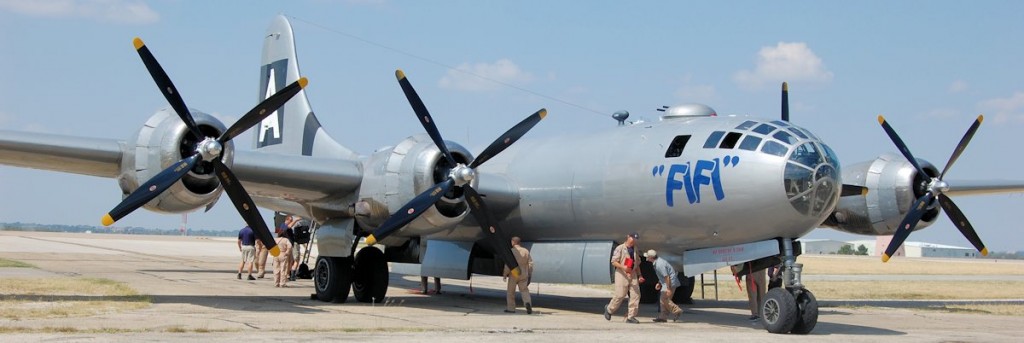
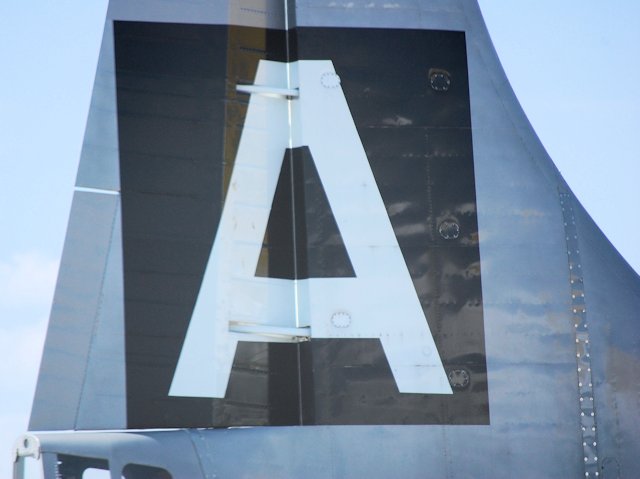 That big A on FIFI’s tail? Stands for “Agather.” And that’s where FIFI’s resurrection from sand and obscurity began. During World War II Vic Agather had been a member of the B-29 development team of the Army Air Forces. In the 1960s he was an early member of the Commemorative Air Force and was instrumental in finding, rescuing, and financing restoration of FIFI.
That big A on FIFI’s tail? Stands for “Agather.” And that’s where FIFI’s resurrection from sand and obscurity began. During World War II Vic Agather had been a member of the B-29 development team of the Army Air Forces. In the 1960s he was an early member of the Commemorative Air Force and was instrumental in finding, rescuing, and financing restoration of FIFI.
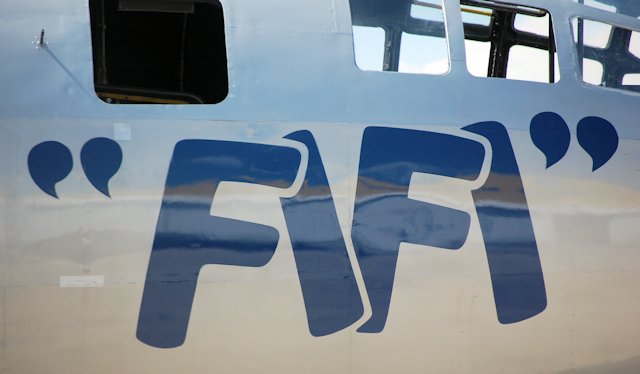 And the name FIFI? Agather named the plane for his wife Josephine.
And the name FIFI? Agather named the plane for his wife Josephine.
The Commemorative Air Force acquired the B-29 in 1971 after a group of CAF members found the old bomber at the million-acre Naval Air Weapons Station at China Lake in the Mojave Desert in California. The airplane was one of thirty-six Superfortresses that had been used for gunnery targets. The airplane, parked in the desert for seventeen years, also had suffered from heat, sand, and vandalism. The CAF, overcoming much government red tape, acquired the airplane for $1. On March 31, 1971 a CAF maintenance team began a rudimentary restoration of the plane—just enough to get it into the air. New parts were fabricated, other B-29s at China Lake were cannibalized for old parts. By August 3 the bomber was airworthy. That day it rose from the desert and flew 1,250 miles to Harlingen, Texas (then home of the CAF). Then came the thorough restoration, lasting three years. After several years of “warbird barnstorming” for the CAF, the plane was grounded for four years for another restoration that included replacing all four engines. Today FIFI is again a barnstorming warbird.
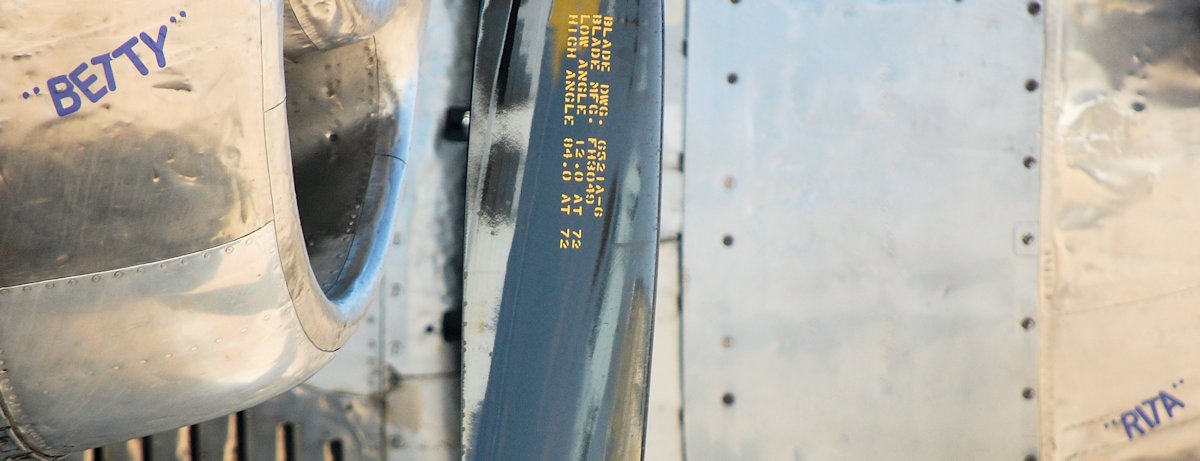 Each of FIFI’s engines is named for a Hollywood actress: Betty (Grable), Rita (Hayworth), Ingrid (Bergman), and Mitzi (Gaynor). Betty and Rita are on the starboard wing.
Each of FIFI’s engines is named for a Hollywood actress: Betty (Grable), Rita (Hayworth), Ingrid (Bergman), and Mitzi (Gaynor). Betty and Rita are on the starboard wing.
Here are the “measurements” of a B-29: (because propellerheads wanna know): length: 99 feet; wingspan: 141 feet; tail height: 27 feet, 9 inches; loaded weight: 120,000 pounds; powerplant: four Wright 2,200-horsepower radial engines; maximum speed: 357 mph; range: 3,250 miles; bomb load: 20,000 pounds; crew: eleven (pilot, copilot, bombardier, flight engineer, navigator, radio operator, radar observer, right gunner, left gunner, central fire control, tail gunner). Cost to operate per hour: about $9,000.
The B-29 dwarfed its predecessor, the B-17 Flying Fortress, just as it would be, in turn, dwarfed by its successor, the bomber plant-built B-36 Peacemaker.
(In July Texas Raiders, one of the few flying B-17 Flying Fortress heavy bombers, was at the Vintage Flying Museum. More than twelve thousand B-17s were built. Fewer than fifty survive, and fewer than twenty are airworthy.)
 Top notch: That notch under the word “Flying” over the double doors of the museum hangar accommodates the tall tail of a B-29. The hangar originally was in San Antonio and was disassembled, moved, and reassembled at Meacham Field.
Top notch: That notch under the word “Flying” over the double doors of the museum hangar accommodates the tall tail of a B-29. The hangar originally was in San Antonio and was disassembled, moved, and reassembled at Meacham Field.
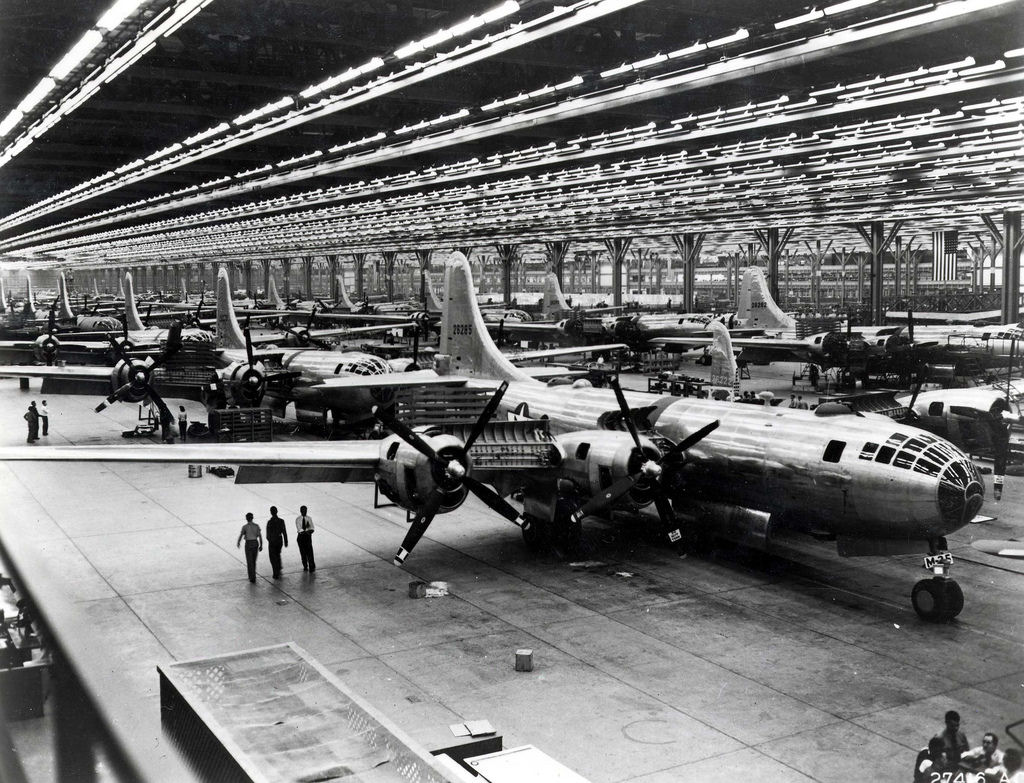 Photo from Wikipedia shows the Boeing B-29 assembly line in Wichita, Kansas in 1944. Out of almost four thousand B-29s built, only twenty-two survive.
Photo from Wikipedia shows the Boeing B-29 assembly line in Wichita, Kansas in 1944. Out of almost four thousand B-29s built, only twenty-two survive.
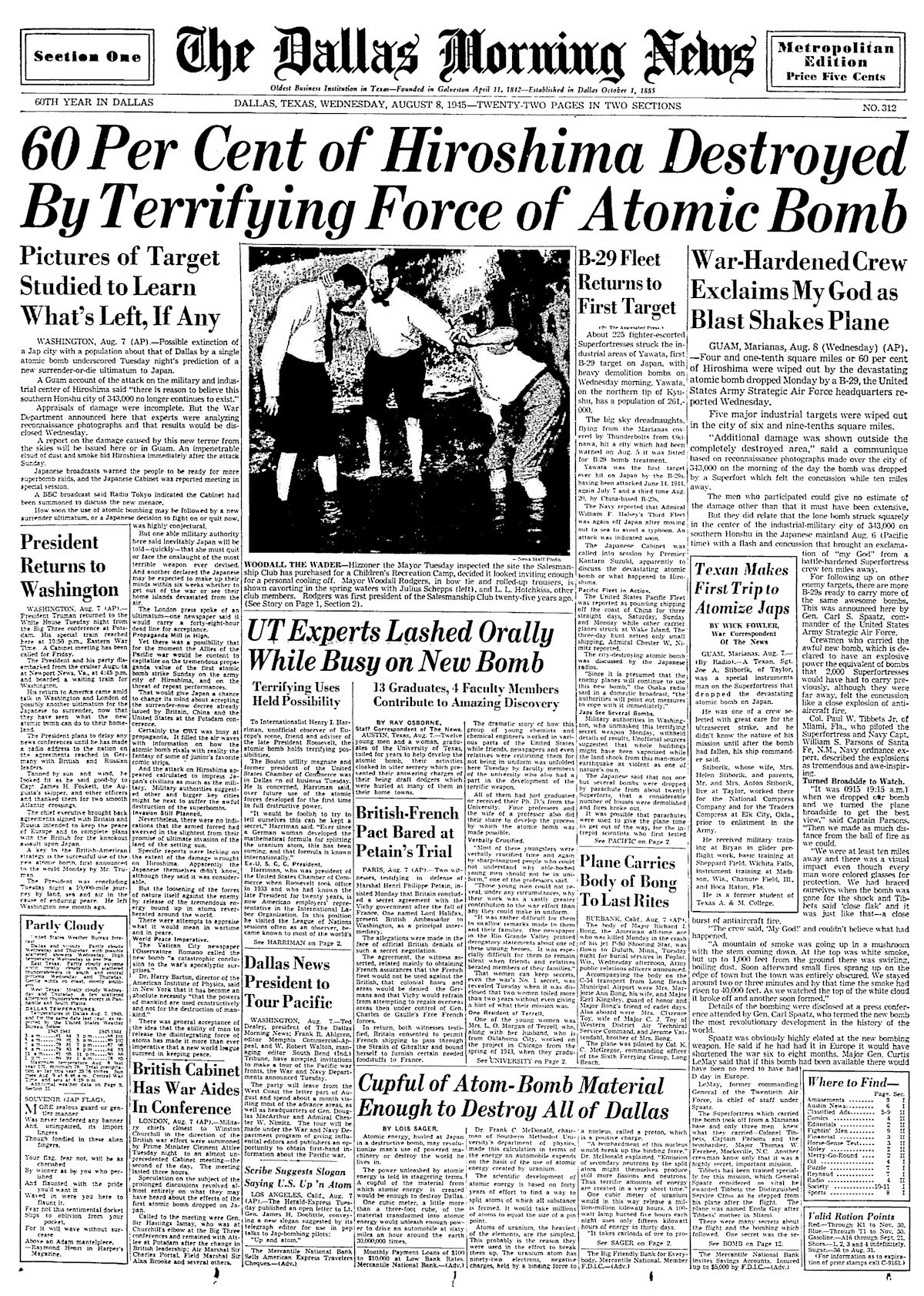 Two of those survivors are the Enola Gay, which dropped the atomic bomb “Little Boy” over Hiroshima, and Bockscar, which dropped the atomic bomb “Fat Man” over Nagasaki during World War II. Clip is from the August 8, 1945 Dallas Morning News.
Two of those survivors are the Enola Gay, which dropped the atomic bomb “Little Boy” over Hiroshima, and Bockscar, which dropped the atomic bomb “Fat Man” over Nagasaki during World War II. Clip is from the August 8, 1945 Dallas Morning News.

 Vic Agather named his B-29 after his wife. Enola Gay pilot Paul Tibbets named his B-29 after his mother.
Vic Agather named his B-29 after his wife. Enola Gay pilot Paul Tibbets named his B-29 after his mother.
At 12:14 p.m. Tuesday FIFI took off from Meacham Field and was soon back in the clouds. By 12:21 she was flying at 185 mph a mile high over Springtown on a heading of 287 degrees west. Two hours and twenty-one minutes later she landed in Albuquerque in the high desert of New Mexico. But her stay in the desert this time was considerably shorter than seventeen years.






God bless Eddie Allen – and General LeMay.